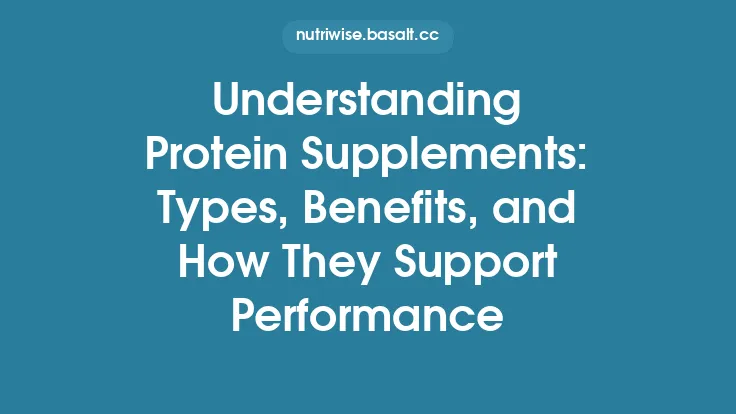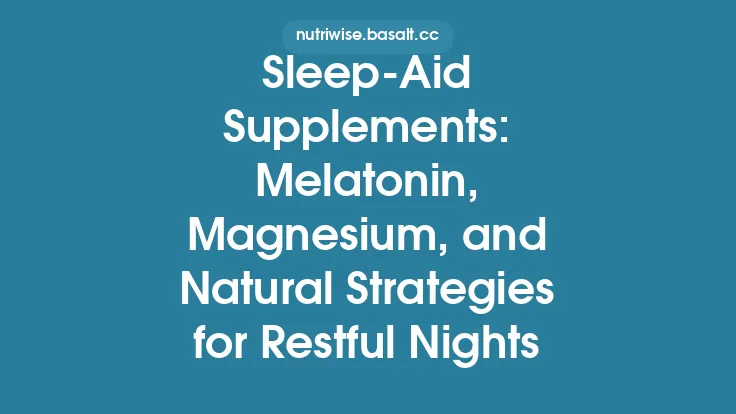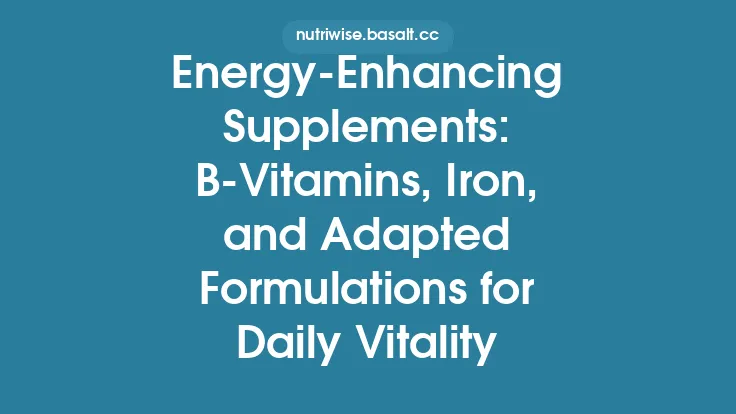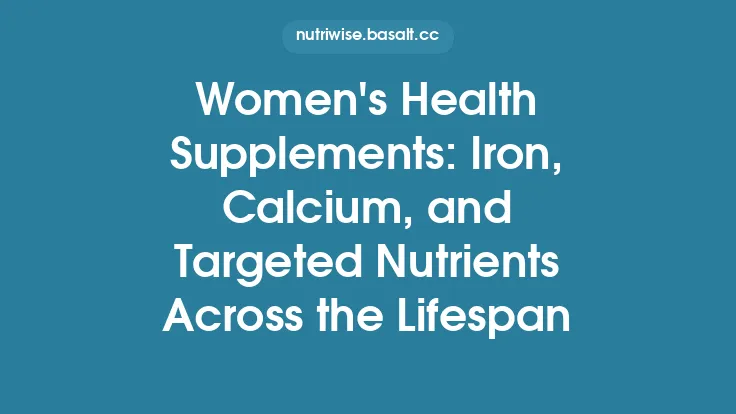Joint comfort is a common concern for people of all ages, whether the discomfort stems from age‑related wear, an active lifestyle, or occasional injury. While physical therapy, movement strategies, and weight management are foundational, many turn to targeted supplements to help maintain cartilage integrity, support synovial fluid health, and modulate inflammation. Below is a comprehensive, evergreen guide to the most studied and promising joint‑focused nutrients, how they work, what the evidence says, and practical tips for selecting and using them safely.
Understanding Joint Anatomy and the Role of Supplements
A typical synovial joint consists of bone ends covered by articular cartilage, a capsule lined with synovial membrane, and a fluid‑filled space that provides lubrication. The cartilage matrix is primarily built from collagen type II, proteoglycans (especially aggrecan), and a water‑rich ground substance that includes glycosaminoglycans (GAGs) such as glucosamine and chondroitin.
Key physiological processes that influence joint comfort include:
| Process | Primary Players | How Supplements May Help |
|---|---|---|
| Cartilage synthesis | Chondrocytes, collagen II, proteoglycans | Provide building blocks (glucosamine, chondroitin, collagen peptides) |
| Matrix turnover | Enzymes (MMPs, ADAMTS) | Anti‑inflammatory agents (MSM, curcumin) may reduce catabolic enzyme activity |
| Synovial fluid viscosity | Hyaluronic acid, lubricin | Direct supplementation can replenish fluid quality |
| Inflammatory signaling | Cytokines (IL‑1β, TNF‑α) | Nutrients with anti‑oxidant or anti‑inflammatory properties can blunt signaling |
Because the joint environment is relatively avascular, delivering nutrients directly to cartilage is challenging. Oral supplements aim to increase systemic availability of precursor molecules, which chondrocytes can then uptake and incorporate into the extracellular matrix.
Glucosamine: Forms, Mechanisms, and Evidence
What it is – Glucosamine is an amino‑sugar (C₆H₁₃NO₅) that serves as a precursor for glycosaminoglycans, the sugar chains that attach to core proteins to form proteoglycans.
Common forms
| Form | Source | Typical dose | Key notes |
|---|---|---|---|
| Glucosamine sulfate | Shellfish shells (or synthetic) | 1,500 mg/day (often as 1,500 mg of the salt) | Most studied; may increase sulfate availability for cartilage synthesis |
| Glucosamine hydrochloride | Synthetic | 1,500 mg/day | Slightly higher elemental glucosamine per gram; less sulfate |
| N‑acetyl‑glucosamine (NAG) | Fermentation | 1,000–2,000 mg/day | Less evidence for joint outcomes; sometimes used for gut health |
Mechanistic insights
- Substrate provision – Chondrocytes incorporate glucosamine into the GAG backbone of aggrecan.
- Osmotic regulation – Increased GAG content improves cartilage’s ability to retain water, enhancing load‑bearing capacity.
- Modulation of inflammatory pathways – In vitro studies show glucosamine can inhibit NF‑κB activation, reducing production of catabolic cytokines.
Clinical evidence
- Meta‑analyses (2010‑2022) of randomized controlled trials (RCTs) report modest but statistically significant reductions in pain scores (≈10–15 % vs. placebo) for individuals with mild‑to‑moderate osteoarthritis (OA) of the knee or hip, especially when glucosamine sulfate is used for ≥ 3 months.
- Responder analyses indicate that ~30 % of participants experience clinically meaningful relief, while the remainder see little change.
- Long‑term safety is well‑established; most studies report no increase in adverse events compared with placebo.
Practical take‑away – Glucosamine sulfate at 1,500 mg/day, taken with meals, is the most evidence‑backed option for joint comfort. Those with shellfish allergies should verify the source or choose a synthetic product.
Chondroitin Sulfate: What It Does and Who Might Benefit
What it is – Chondroitin is a sulfated GAG composed of repeating disaccharide units (N‑acetylgalactosamine and glucuronic acid). It is a major component of cartilage proteoglycans, contributing to resilience and resistance to compression.
Typical dosing – 800–1,200 mg/day, often divided into two doses.
Mechanisms of action
- Matrix reinforcement – Provides sulfate groups needed for the synthesis of new proteoglycans.
- Inhibition of degradative enzymes – In vitro, chondroitin can suppress aggrecanases (ADAMTS‑4/5) that break down cartilage.
- Anti‑inflammatory effect – May reduce prostaglandin E₂ production in synovial cells.
Evidence snapshot
- Large RCTs such as the GAIT (Glucosamine/Chondroitin Arthritis Intervention Trial) found that the combination of glucosamine + chondroitin produced a modest benefit in participants with moderate to severe knee pain, but the effect was less pronounced in those with mild symptoms.
- Meta‑analyses suggest chondroitin alone yields a small reduction in pain and improvement in function, comparable to NSAIDs in some trials but with a superior safety profile.
- Disease‑modifying potential – Some longitudinal studies report slower radiographic progression of knee OA in chondroitin users, though findings are not unanimous.
Practical take‑away – Chondroitin sulfate is most useful when paired with glucosamine, especially for individuals with moderate joint discomfort. A daily dose of 1,200 mg, taken with food, is standard.
Synergistic Combinations: Glucosamine‑Chondroitin and Beyond
Why combine? – The two nutrients supply complementary building blocks (amino‑sugar vs. sulfated GAG) and may exert additive anti‑inflammatory effects.
Formulation tips
- Fixed‑dose combos often contain 1,500 mg glucosamine sulfate + 1,200 mg chondroitin sulfate per day.
- Timing – Splitting the dose (e.g., half in the morning, half in the evening) can improve gastrointestinal tolerance.
- Add‑ons – Many products incorporate MSM, hyaluronic acid, or turmeric extract to broaden the mechanistic coverage.
Evidence for combos
- The GAIT trial’s subgroup analysis indicated that participants with higher baseline pain experienced the greatest benefit from the glucosamine + chondroitin combo.
- Subsequent meta‑analyses (2021‑2023) confirm a small but consistent advantage of the combination over either ingredient alone for pain reduction and functional improvement.
Practical take‑away – For individuals seeking a “one‑stop” joint supplement, a high‑quality glucosamine‑chondroitin combo is a logical first choice. Adding a secondary agent (e.g., MSM) can be considered if additional anti‑inflammatory support is desired.
Methylsulfonylmethane (MSM): A Sulfur‑Rich Ally
What it is – MSM is an organic sulfur compound (CH₃)₂SO₂ that supplies bioavailable sulfur, a key element in the synthesis of collagen, glucosamine, and other connective‑tissue components.
Typical dose – 1,500–3,000 mg/day, divided into two doses.
Mechanistic highlights
- Anti‑oxidant activity – Scavenges free radicals, reducing oxidative stress in joint tissues.
- Inflammation modulation – Inhibits NF‑κB and COX‑2 pathways, lowering prostaglandin synthesis.
- Pain perception – May influence transient receptor potential (TRP) channels involved in nociception.
Clinical evidence
- RCTs in knee OA participants show that 3 g/day of MSM reduces pain scores by ~20 % compared with placebo after 12 weeks, with improvements in walking distance.
- A systematic review (2022) concluded that MSM is safe, with mild gastrointestinal upset being the most common adverse event.
Practical take‑away – MSM is a valuable adjunct for individuals who need extra anti‑inflammatory support or who experience mild gastrointestinal sensitivity to glucosamine/chondroitin. It can be taken alongside those ingredients without known interactions.
Hyaluronic Acid and Joint Lubrication
What it is – Hyaluronic acid (HA) is a high‑molecular‑weight polysaccharide that contributes to the viscoelastic properties of synovial fluid, providing shock absorption and lubrication.
Oral vs. injectable – While intra‑articular HA injections are a medical treatment for knee OA, oral HA supplements aim to increase systemic HA levels, potentially supporting synovial fluid quality.
Dosage – 100–200 mg/day of low‑molecular‑weight HA (often derived from rooster combs or bacterial fermentation).
Mechanistic notes
- Stimulates endogenous HA synthesis – Oral HA may up‑regulate hyaluronan synthase enzymes in synoviocytes.
- Anti‑inflammatory – HA can bind CD44 receptors, modulating immune cell activity within the joint capsule.
Evidence
- Small RCTs (n ≈ 80–120) report modest reductions in pain and stiffness after 8–12 weeks of oral HA, comparable to glucosamine in some studies.
- Meta‑analyses suggest a benefit magnitude of ~10 % over placebo, with a favorable safety profile.
Practical take‑away – Oral HA is a reasonable addition for those seeking to improve joint lubrication, especially when combined with glucosamine/chondroitin or MSM.
Collagen Peptides for Cartilage Support
What they are – Hydrolyzed collagen (type II or a blend of types I/III/II) provides short peptide fragments rich in glycine, proline, and hydroxyproline, the amino acids essential for collagen synthesis.
Typical dosing – 5–10 g/day of type II collagen peptides (often derived from chicken sternum) or 10 g/day of a mixed collagen blend.
Mechanisms
- Substrate supply – Provides the amino acid building blocks for new collagen fibers in cartilage and tendons.
- Oral tolerance induction – Low‑dose undenatured type II collagen may promote immune tolerance to cartilage collagen, reducing autoimmune‑driven degradation (a concept known as “oral tolerance”).
Evidence
- RCTs with undenatured type II collagen (40 mg/day) have shown reductions in joint pain comparable to NSAIDs over 90 days, with no gastrointestinal side effects.
- Hydrolyzed collagen (10 g/day) trials demonstrate improvements in joint function scores after 12–24 weeks, especially in active adults and athletes.
Practical take‑away – For individuals focused on structural support and those who prefer a protein‑based supplement, collagen peptides (especially undenatured type II) are a compelling option. They can be mixed into beverages or taken as capsules.
Herbal and Botanical Extracts with Joint‑Targeted Actions
| Extract | Key constituents | Primary joint‑related actions | Typical dose |
|---|---|---|---|
| Turmeric (Curcuma longa) – standardized curcumin | Curcuminoids (≈95 % curcumin) | COX‑2 inhibition, NF‑κB suppression, antioxidant | 500–1,000 mg/day (with piperine or liposomal formulation for absorption) |
| Boswellia serrata (frankincense) – AKBA | 3‑Acetyl‑11‑keto‑β‑boswellic acid | Inhibits 5‑LOX, reduces leukotriene synthesis, protects cartilage | 300–500 mg/day of standardized extract |
| White willow bark | Salicin (natural aspirin precursor) | Mild COX inhibition, analgesic effect | 120–240 mg salicin equivalents |
| Ginger (Zingiber officinale) | Gingerols, shogaols | Anti‑inflammatory, reduces prostaglandin synthesis | 500–1,000 mg/day of standardized extract |
| Cat’s claw (Uncaria tomentosa) | Oxindole alkaloids | Modulates cytokine production, antioxidant | 250–500 mg/day |
Evidence highlights
- Curcumin combined with piperine has demonstrated pain reductions of 30–40 % in knee OA trials lasting 8–12 weeks.
- Boswellia extracts have shown comparable improvements in WOMAC (Western Ontario and McMaster Universities Osteoarthritis Index) scores to NSAIDs in several RCTs, with a markedly lower adverse‑event rate.
- Ginger and white willow bark provide modest analgesia and are often used as adjuncts to primary joint supplements.
Practical take‑away – Herbal extracts can complement the core nutrients (glucosamine, chondroitin, MSM) for a multi‑modal approach. Choose standardized extracts with documented bioavailability (e.g., curcumin‑piperine complexes) and monitor for gastrointestinal sensitivity.
Choosing Quality Products and Dosage Guidelines
- Third‑party testing – Look for certifications from NSF International, USP, or ConsumerLab to ensure label accuracy and absence of contaminants (e.g., heavy metals, shellfish allergens).
- Formulation integrity – Products that combine glucosamine sulfate, chondroitin sulfate, and MSM in a single capsule often use a delayed‑release coating to protect the ingredients from stomach acid and improve absorption.
- Bioavailability enhancers –
- Piperine (black‑pepper extract) boosts curcumin absorption up to 20‑fold.
- Liposomal or micellar delivery can improve the uptake of hyaluronic acid and curcumin.
- Timing – Taking joint supplements with meals containing some fat can enhance the absorption of fat‑soluble components (e.g., curcumin).
- Loading phase – Some clinicians recommend a short “loading” period of 2–4 weeks at the upper end of the dosage range to saturate joint tissues, followed by a maintenance dose.
Sample regimen for moderate knee discomfort
| Time of day | Supplement | Dose |
|---|---|---|
| Morning (with breakfast) | Glucosamine sulfate | 1,500 mg |
| Morning | Chondroitin sulfate | 1,200 mg |
| Mid‑day (with lunch) | MSM | 1,500 mg |
| Evening (with dinner) | Hyaluronic acid | 200 mg |
| Evening | Curcumin‑piperine complex | 500 mg |
| As needed | Boswellia extract | 300 mg |
*Adjust doses based on individual tolerance, product concentration, and professional guidance.*
Safety, Interactions, and When to Seek Professional Advice
| Concern | Details |
|---|---|
| Allergies | Glucosamine is often derived from shellfish; verify source if allergic. |
| Blood thinning | High‑dose glucosamine may modestly increase INR in warfarin users; monitor coagulation parameters. |
| Diabetes | Some studies suggest glucosamine could affect glucose metabolism; diabetics should check blood sugar regularly. |
| Pregnancy & lactation | Limited safety data; most clinicians advise avoiding high‑dose glucosamine/chondroitin unless prescribed. |
| Kidney disease | MSM and high protein loads (collagen) may increase nitrogenous waste; consult a nephrologist. |
| Medication interactions | NSAIDs + high‑dose herbal anti‑inflammatories (e.g., willow bark) may increase gastrointestinal bleeding risk. |
Red flags that warrant medical evaluation
- Persistent swelling, warmth, or redness in a joint (possible infection).
- Sudden loss of joint function or severe pain unresponsive to supplements.
- New onset of systemic symptoms (fever, unexplained weight loss).
When in doubt, a conversation with a primary‑care physician, rheumatologist, or a registered dietitian experienced in sports nutrition can help tailor a supplement plan to personal health status.
Future Directions and Emerging Nutrients
Research continues to explore novel compounds that may complement or surpass current joint‑support supplements:
- Undenatured type II collagen peptides are being investigated for immune‑modulating effects that could slow cartilage auto‑destruction.
- S-adenosyl‑methionine (SAMe), a methyl donor involved in cartilage matrix synthesis, shows promise in head‑to‑head trials against NSAIDs.
- Plant‑derived polyphenols such as epigallocatechin‑3‑gallate (EGCG) from green tea are under study for their ability to inhibit MMP activity.
- Targeted probiotic strains (e.g., *Lactobacillus reuteri*) may influence systemic inflammation and, indirectly, joint health.
- Nanoparticle delivery systems aim to improve the bioavailability of large molecules like hyaluronic acid and curcumin, potentially reducing required dosages.
Staying abreast of peer‑reviewed literature and clinical trial registries will help consumers and clinicians adopt evidence‑based innovations as they become available.
Bottom line – A well‑rounded joint‑comfort regimen typically starts with the foundational trio of glucosamine sulfate, chondroitin sulfate, and MSM, supplemented as needed with hyaluronic acid, collagen peptides, and anti‑inflammatory botanicals. Selecting high‑quality, third‑party‑tested products, adhering to evidence‑based dosing, and monitoring for safety signals can provide sustainable relief and support the structural integrity of joints over the long term.





